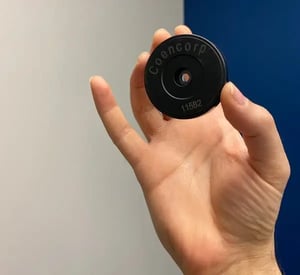
If jerrycans are a fact of your fleet life, you know how hard it is to keep track of the fuel they consume. You’ve probably resigned yourself to accepting the lack of accountability that comes with jerrycan use as a necessary evil.
We’re here to tell you it doesn’t have to be this way. The fuel dispensed via jerrycans can be tracked and managed accurately and cost-effectively. Read on to learn how.
Your Fuel Management System's Blind Spot
As a fleet manager, your success depends in no small part on controlling costs, and fuel is a major cost of operating a fleet, second only to maintenance.
Accordingly, you’re doing everything possible to manage in-house fueling tightly. You may have played a part in selecting an automated fuel management system. You researched the available systems and vendors. Selected the most suitable one. Deployed the system. Trained staff on how to use it.
After ironing out a few wrinkles, your fuel management system is operational and doing well for the most part. It’s likely doing a decent job of tracking and reporting on your vehicles’ consumption and inventories.
But all is not perfect. In commercial fleet operations, the use of jerrycans is often unavoidable. Fuel dispensed to jerrycans is nearly impossible to track, creating a constant headache. Like the proverbial leaky faucet, the endless drip, drip, drip of fuel consumed by jerrycans is a nagging annoyance.
And it’s not just jerrycans; you may be dealing with all sorts of gas-powered tools:
- lawnmowers
- chainsaws
- blowers and vacuums
- pressure washers
- trimmers
- handheld sweepers
Over time, it adds up to significant volumes poured into a black hole of accountability.
Why Standard Fuel Management Systems Fall Short
To get a clear picture of the solution, it helps to consider a standard fuel management system configuration. The classic refuelling operation goes something like this:
- A user drives up to a fuel island terminal near the dispensers.
- The user identifies him/herself and the vehicle to the system; this is done by some combination of keypad entry and RFID card or key fob (note: in a classic setup, the card reader is surface mounted either on the outside or inside the fuel island terminal enclosure).
- The system confirms the entered credentials.
- After optional odometer and/or engine hours entry, the requested dispenser is unlocked and fueling proceeds.
Regrettably, this standard setup cannot handle jerrycans very well because jerrycans are typically general purpose for use across the organization by anyone who needs them, so assigning jerrycans unique ID numbers as you do for vehicles is impractical.
Further, many fuel management systems have a limit on the number of vehicles they can handle so consuming vehicle “slots” for jerrycans is wasteful, especially if you have a large number of them.
How Should Fuel Management Be Done?
SM2-FUEL solves this problem with a unique configuration of RFID readers and tags.
First, in lieu of (or in addition to) the standard surface-mounted card reader, the fuel island terminal is supplied with a rugged, corded RFID reader.
This reader is attached to the fuel island terminal by an industrial-grade coiled cable cut to any desired length, typically 12 feet. The reader can be attached directly to the terminal or routed to it via a conduit, as seen in the installation pictured below. 
Next, inexpensive disc-shaped RFID tags are fastened to jerrycans, lawnmowers, chainsaws, and other gas-powered small tools—anything that uses fuel. These tags serve exactly the same purpose as barcode labels, only better because they can be read in any orientation and are unaffected by dirt, grime, mud, etc.
The tags cost only a few dollars each, allowing the tracking of hundreds of jerrycans and gas-powered tools cost-effectively. 
With a minor difference, the jerrycan (or gas-powered tool) fueling operation is identical to the standard sequence:
- A user needing fuel presents herself at the fuel island terminal.
- She identifies herself to the system as before.
- At the vehicle identification step, she scans the RFID disc permanently fastened to the jerrycan (which is now done easily thanks to the corded reader)
- The requested dispenser is unlocked, and fueling proceeds.
Instead of a standard configuration fixed RFID reader, the fuel island terminal is fitted with a rugged, corded reader. The reader is attached to the terminal by a coiled electrical cable, allowing the RFID disc to be scanned easily.
This configuration delivers several benefits:
- Fuel dispensed to jerrycans and gas-powered tools can now be tracked accurately.
- Jerrycan and gas-powered consumption can be attributed to departments or cost centers.
- Because the RFID disc is permanently fastened to the jerrycan or gas-powered tool, the equipment must be physically present, thereby reducing the possibility of fraud.
- No keypad entry makes refuelling quick and easy—system users love it.
- Increased accountability tends to keep employees honest and managers happy.
Take the First Step to automate your fuel management
A jerrycan by itself does not represent a big volume of fuel. But combine enough of them with a lack of tracking and management, and those little jerrycans become a big problem. Luckily there is a solution beyond what the run-of-the-mill fuel management system offers. SM2-FUEL fulfils the promise of end-to-end fuel inventory management with an inexpensive, easy-to-implement solution.
Contact us today to discuss how we can help fix the leaky faucet in your fuel management efforts.
